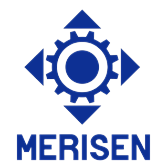
Focusing on Couplers: Selection and Introduction
2025-09-02 08:30Focusing on Couplers: Selection and Introduction
Couplers are fundamental mechanical components used to connect two shafts together, transmitting torque and rotation while accommodating minor misalignments. Selecting the right coupler is crucial for the efficiency, reliability, and longevity of machinery. Here's a breakdown focusing on common solid/shaft coupling types relevant to industrial applications:
1. Rigid Couplings:
* Purpose: Provide a solid connection between two shafts. Used when shafts are precisely aligned (both angularly and parallelly) and no flexibility is required or desired.
* Key Characteristics:
* Zero Backlash: Essential for precision applications like CNC machining or servo drives where positional accuracy is critical.
* High Torsional Stiffness: Transmits torque efficiently without wind-up or torsional deflection.
* High Precision: Maintains precise shaft positioning.
* No Misalignment Compensation: Requires perfect shaft alignment during installation. Misalignment causes significant stress on shafts, bearings, and the coupling itself, leading to premature failure.
* Common Types:
* Flanged Couplings: Consist of two hubs with flanges bolted together. Simple, robust, and capable of transmitting high torque.
* Sleeve Couplings (or Muff Couplings): A single cylindrical piece that fits over the ends of two shafts, connected by keys or splines. Compact but requires disassembly of equipment for installation/removal.
* Clamp or Compression Couplings: Use radial screws to clamp directly onto the shafts. Easy installation/removal without moving equipment. Good for high speeds.
2. Flexible Couplings (Highlighting Solid Element Types):
* Purpose: Connect shafts while accommodating minor misalignments (parallel, angular, axial). Absorb shock loads and dampen vibration, protecting connected equipment.
* Key Characteristics (for Solid Element Types):
* Misalignment Compensation: Can handle small amounts of shaft misalignment.
* Torsional Stiffness: Generally high, though less than rigid couplings. Some types offer controlled flexibility.
* Backlash: Many modern flexible couplings are designed to be zero-backlash or low-backlash.
* Damping: Can absorb shock loads and dampen vibrations.
* Common Solid Element Flexible Types:
* Jaw Couplings (Spider Couplings): Feature two metal hubs with curved jaws and an elastomeric spider (insert) between them. The spider absorbs shock, dampens vibration, and allows for misalignment. Common, cost-effective, easy to maintain (replace spider).
* Disc Couplings: Use one or more thin, flexible metal discs bolted between two hubs. Transmit torque purely through the discs. Offer high torsional stiffness, zero backlash, and excellent misalignment capability. Handle high speeds and temperatures. Require good alignment but are very reliable.
* Grid Couplings: Utilize a slotted grid spring nested between two grooved hubs. The grid flexes to accommodate misalignment and absorbs shock. Robust, suitable for moderate to heavy-duty applications. Requires lubrication.
* Gear Couplings: Consist of two hubs with external gear teeth connected by a sleeve with internal teeth. High torque density, good misalignment capability. Require lubrication and can potentially have backlash. Common in heavy industrial applications like steel mills.
* Oldham Couplings: Use three discs: two hubs connected to the shafts and a center disc with perpendicular tongues that slide in slots on the hubs. Accommodates parallel misalignment well. Zero backlash potential. Lower torque capacity than disc or gear types.
Key Factors for Coupler Selection:
Torque Requirement: The coupling must handle the peak torque (including shock loads) of the application without failure. Calculate or estimate the required torque.
Shaft Sizes: The coupling must fit the diameters of both shafts.
Misalignment: Determine the expected amount of parallel, angular, and axial misalignment. Choose a coupling type rated for those levels.
Speed (RPM): Ensure the coupling is rated for the maximum operating speed.
Backlash Requirement: Precision applications (servos, encoders) often require zero-backlash couplings (e.g., disc, some jaw/spider, Oldham, rigid).
Torsional Stiffness: Applications needing precise motion control (CNC, robotics) require high torsional stiffness (e.g., disc, rigid).
Space Constraints: Consider the available space for the coupling length and diameter.
Environment: Consider temperature,
chemicals, dust, moisture. Affects material choice (e.g., stainless steel vs. aluminum) and element type (e.g., special elastomers for high temp).
Maintenance: Consider lubrication requirements and ease of element replacement (e.g., spider in jaw couplings).
Cost: Balance performance requirements with budget.
In Summary:
Choosing the right coupler is critical. For a solid connection with perfect alignment, Rigid Couplings (flanged, clamp, sleeve) are used. For flexibility and misalignment compensation, Solid Element Flexible Couplings like Jaw/Spider, Disc, Grid, Gear, and Oldham types are prevalent. Dalian Mairuisheng, operating as a distributor, can provide these essential components, but selection requires careful consideration of the application's specific torque, speed, misalignment, and precision needs.
